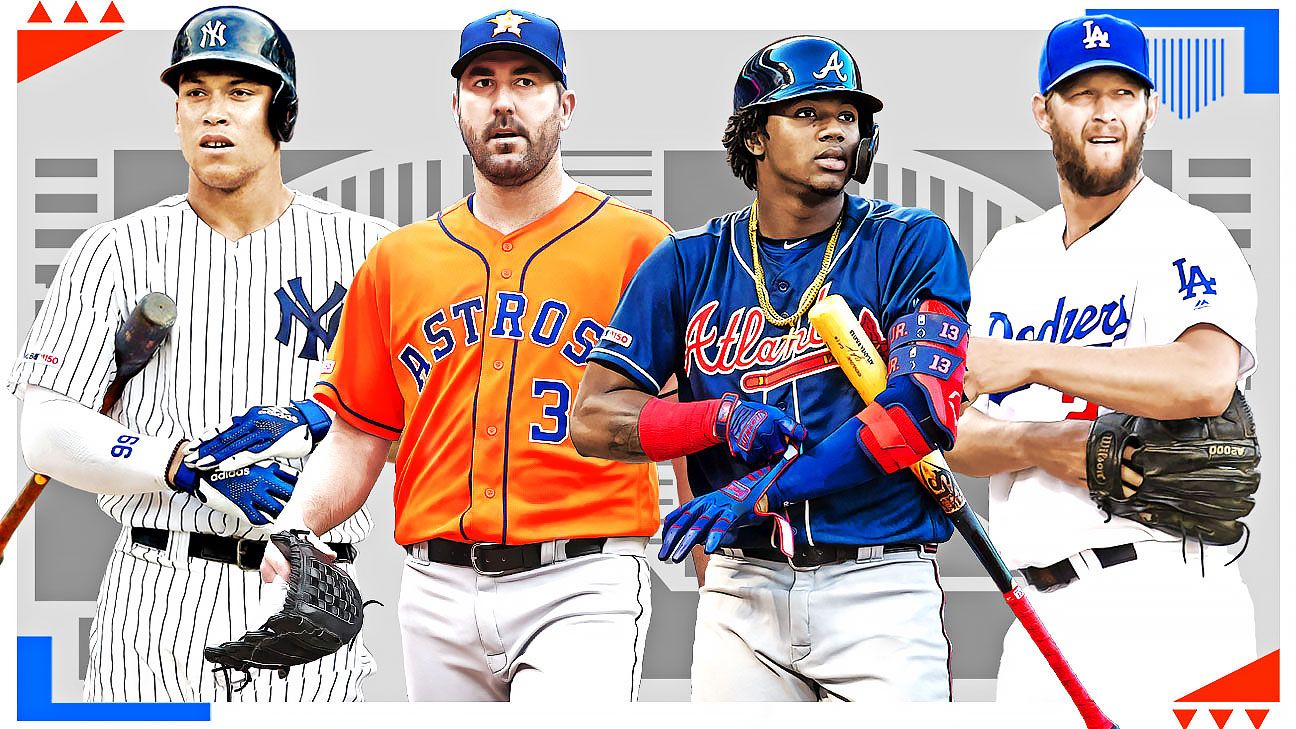Whether you are a die-hard fan who has been following every pitch since Opening Day or playing catch-up as the 2019 MLB postseason begins, the start of October means the best time of the baseball season is ahead of us.
Will anyone keep this month from belonging to the Houston Astros? Can the Los Angeles Dodgers finally win it all after two straight World Series losses? Is this the year the Yankees return to the top of the baseball universe? Or will a surprising story overcome the three superteams that have dominated the season?
As 10 teams enter the playoffs with hopes of a World Series run, we enlisted ESPN.com’s Bradford Doolittle, Sam Miller, Jeff Passan and David Schoenfield to provide odds for every matchup, players to watch, scouting reports, predictions and much more.
Jump to each postseason team:
NL: Dodgers | Braves | Cardinals | Nationals | Brewers
AL: Astros | Yankees | Twins | Athletics | Rays

October overview
World Series odds by team
(Odds from Bradford Doolittle’s MLB projection system)
Houston Astros 33%
Los Angeles Dodgers 26%
New York Yankees 11%
ESPN.com expert October rankings
1. Astros (No. 1 lineup | No. 1 pitching staff)
2. Dodgers (No. 3 lineup | No. 2 pitching)
3. Yankees (No. 2 lineup | No. 5 pitching)
4. Twins (No. 4 lineup | No. 7 pitching)
5. Nationals (No. 6 lineup | No. 4 pitching)
6. Braves (No. 5 lineup | No. 9 pitching)
7. A’s (No. 7 lineup | No.8 pitching)
8. Rays (No. 9 lineup | No. 3 pitching)
9. Cardinals (No. 10 lineup | No. 6 pitching)
10. Brewers (No. 8 lineup | No. 10 pitching)

National League wild-card game
Brewers at Nationals (8 ET, Tuesday on TBS)
Sure, the Brewers would have preferred to have won the division, but in one way it’s beneficial the way everything unfolded on Sunday as they were able to rest all their best relievers — most notably Josh Hader — for Tuesday’s wild-card game. The pitching staff will have to come up big, because you have to think Max Scherzer — with Stephen Strasburg a good bet to appear in relief given the shaky relief corps of the Nationals — will be stingy with the runs. It was the pitching that carried the Brewers through their September surge with the best ERA in the majors.
Milwaukee Brewers
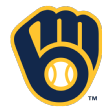
89-73 | NL wild card | 1% World Series odds
Odds by round
Wild-card round: 39% vs. Nationals
NLDS: 27% vs. Dodgers
NLCS: 42% vs. Cardinals, 35% vs. Braves
World Series: 34% vs. Yankees, 21% vs. Astros, 41% vs. Twins, 43% vs. A’s, 43% vs. Rays
What they do better than everyone else: The Brewers are so consistently difficult to explain or project that it’s hard to say exactly what they are doing that’s so successful. What we can say is that after three years of this, Craig Counsell, David Stearns and their Milwaukee colleagues see something the rest of us don’t. It surely has something to do with breaking the game down into micro-situations, leveraging the available talent to navigate each situation in the most efficient way possible, and the front office making sure that Counsell has the right tools with which to manage as many of those situations as possible. — Doolittle
One flaw that could doom them: As Forrest Gump might say: Sometimes there just aren’t enough rocks. The Brewers tore through September with a roster weakened by Christian Yelich‘s injury, mostly thanks to a run-prevention unit that featured 20 pitchers with at least one inning pitched in September alone, only one of whom (Jordan Lyles) averaged even five innings per outing. Obviously, Counsell won’t have that many arms with which to work on a September roster — though he can keep on in the same vein in the NL wild-card game. However, if Milwaukee survives the Nationals, will Counsell have enough arms to match up with the Dodgers? — Doolittle
Their Mr. Excitement: Well, their Mr. Excitement is out for the playoffs with a fracture kneecap. So let’s go with rookie second baseman Keston Hiura. Everyone loves rookies and with Christian Yelich out, Hiura is the team’s best hitter, a line drive smokin’ machine with surprising over-the-fence power for his size. — Schoenfield
Their best player you’ve never heard of: Pick a set-up reliever, any set-up reliever. The Brewers, as they did last year, have remade their bullpen on the fly, with relief aces emerging out of failed turns in the rotation, little noticed trade deadline pickups, and previously undistinguished resumes. Freddy Peralta and Brent Suter are options here, but Drew Pomeranz wins it: His career seemed endangered after a 6.08 ERA with Boston last year, and he was nearly as bad after the Giants gave him one more chance in the starting rotation this season. When San Francisco moved him to the bullpen he picked up 2 mph on his fastball; with Milwaukee, he’s added one more. He has faced 48 batters in September and struck out more than half of them, walking only one, allowing a .152/.167/.283 slash line and a 2.03 ERA. — Miller
Their season in a game: The Brewers, paradoxically, had an MVP candidate in the heart of their lineup but won far more of their games when he wasn’t playing: They were 67-63 when Yelich played, 22-10 when he didn’t. They also won, usually by the skin of their teeth, with a run differential that was negative right up until the final week of the season, and which ended up about 100 runs behind the Cubs. And more than any team in the NL, they asked for only four or five innings from the starting pitcher. The game: a 4-3 win over Miami, Sept. 10. The Brewers were 46% likely to win that game when Yelich fouled a ball off his knee and had to be removed. They managed to win anyway, despite getting fewer hits, drawing fewer walks and striking out more often than the Marlins. Their starter went four innings; their bullpen was nails. — Miller
Passan’s Inside Intel: The suspicion over the staying power of NL Central teams isn’t limited to the Cardinals — and that goes double for a Brewers team missing Yelich, and with a hobbled Lorenzo Cain and on-the-mend Ryan Braun. “Without their best player, I find it very difficult [to believe they advance deep into the playoffs], even though they’ve been incredibly resilient,” one executive said. “I go back to the quality of the teams they played down the stretch. They didn’t play the Cardinals. They finished with a dying Cubs team, the Reds, the Pirates, the Rockies. That doesn’t mean anything other than they finished out their schedule incredibly well. But there’s a guy named Scherzer. I don’t care how hot you are.”
The Brewers blitzed the postseason on the back of pitching that showed up in September after a three-month-long absence. Their June, July and August ERAs hovered between 4.86 and 4.92. In September: 3.01. As good as their starters were, their bullpen’s dominance was as shocking as it was acute. In 66⅔ innings, the five-headed monster of Peralta, Suter, Pomeranz, Junior Guerra and closer Josh Hader struck out 97 (more than 13 per nine innings), walked 11 and posted a 1.76 ERA.
In the wild-card game, a scout who focused on the Brewers recently said, “I know the industry says you should start [Brandon] Woodruff. I’m telling you, if they start a guy like Suter or Gio [Gonzalez] — the Nationals crush fastballs and struggle a lot more with changeups and change-of-pace guys. The only guy in their lineup who makes true adjustments is [Anthony] Rendon. You could basically eliminate five or six of the guys in their lineup with a change-of-pace guy. Once you get into the Nationals’ bullpen, you have a shot — though that bullpen may consist of [Stephen] Strasburg or [Patrick] Corbin.” … Woodruff will get the start, though he’s not likely to be in there very long. He missed nearly two months because of an oblique strain and just came back in late September, not even reaching 40 pitches in either of his two starts.
Washington Nationals
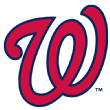
93-69 | NL wild card | 9% World Series odds
Odds by round
Wild-card round: 61% vs. Brewers
NLDS: 40% vs. Dodgers
NLCS: 61% vs. Cardinals, 51% vs. Braves
World Series: 51% vs. Yankees, 34% vs. Astros. 57% vs. Twins, 59% vs. A’s, 59% vs. Rays
What they do better than everyone else: The Nationals didn’t have baseball’s highest-scoring offense, but they did perhaps have its most diverse. And that diversity of options could serve Dave Martinez’s club well in October. With NL MVP candidate Anthony Rendon leading the way, the Nats ranked second in senior circuit scoring despite ranking “just” sixth in homers. Washington was second in on-base percentage, next to last in strikeouts, second in steals and third on average. Home runs are important, and Washington certainly has power threats, beginning with Rendon and Juan Soto. But perhaps no other NL team has more ways to beat you on offense. — Doolittle
One flaw that could doom them: Relief pitching has been a problem for Washington all season and the Nats enter the playoffs with a bullpen ERA closer to 6.00 than 5.00, one of the worst marks ever for an October participant. Even reliable closer Sean Doolittle has wavered at times during the second half, perhaps because of a heavy early workload. Who is going to step up? Fernando Rodney? Daniel Hudson? Wander Suero? The good thing for the Nats is that given the randomness of the playoffs and the volatility of relievers, anything can happen over the next few weeks. Given Washington’s powerhouse rotation, if two or three relievers get hot, look out. — Doolittle
Their Mr. Excitement: Trea Turner isn’t their best player — that’s MVP candidate Anthony Rendon — but he’s their most exciting, setting the table at the top of the lineup with his blazing speed and a little pop. The defensive metrics say he’s had a below-average season in the field, but he can certainly make the acrobatic play. — Schoenfield
Their best player you’ve never heard of: Center fielder Victor Robles didn’t appear in the majors as a fully formed offensive force, as many his top-prospect contemporaries have. But his defense, after some early-season sloppiness, has been nearly as impressive as Keston Hiura’s or Fernando Tatis’ hitting. Robles led all major league outfielders in Statcast’s Outs Above Average, by a lot: Only seven other outfielders reached double digits at all, while Robles was at 21 extra outs. At Baseball-Reference, he led all major leaguers in defensive WAR. — Miller
Their season in a game: The Nationals’ bullpen is, you’ve heard, bad. It’s worse than that: They have the fifth-highest bullpen ERA since modern bullpen usage took over in 1988, and the other four teams averaged 99 losses. But the Nationals are tied for the second-most runs in the NL this year, and their top three starters are all among the 15 or so best starting pitchers in the majors. The game: a 10-4 victory over Miami on Sept. 21. Stephen Strasburg threw seven shutout innings and led 4-0 when he departed. He got a no-decision, the lead blown just one out after the bullpen took over. The Nationals won anyway, with a six-run inning. — Miller
Passan’s Inside Intel: “I don’t think many people realize it,” said one scout who saw the Nationals recently, “but they can really hit.” He’s not wrong. Rendon should finish third in MVP voting. Soto is going to find himself there sooner than later. Turner is a righteous third banana in a lineup. Howie Kendrick is slashing .344/.395/.572 in more than 350 plate appearances. Since joining the Nationals, Asdrubal Cabrera has been reborn: .323/.404/.565 in nearly 150 PA. Add in Adam Eaton regularly in right field, Ryan Zimmerman and Matt Adams providing support for Kendrick at first, Yan Gomes and Kurt Suzuki at catcher, the underappreciated Robles and Baby Shark Gerardo Parra as a do-everything bench bat, and the Nationals have the sort of lineup that can really jump on left-handed starters — three of whom they’ll see in Clayton Kershaw, Hyun-Jin Ryu and Rich Hill if they can get past Milwaukee. … “I’ll take Rendon and Soto over any other duo in the NL,” another scout said. “[Ronald] Acuna and [Freddie] Freeman. [Cody] Bellinger and [Max] Muncy. Give me Rendon and Soto.”
Multiple scouts who have seen Max Scherzer recently don’t exactly disagree with the Nationals’ decision to start him in the wild-card game. “I just hope Davey has a quick hook,” one scout said, “because he hasn’t looked the same.” … While the Hunter Strickland and Roenis Elias deadline acquisitions didn’t exactly work out, Hudson has been revelatory for the Nationals. “I’m not sure they make the playoffs without him,” one evaluator said. Hudson served as closer for most of September, in which he threw nine scoreless appearances. His totals with Washington: 25 innings, 23-to-4 strikeout-to-walk ratio, 1.44 ERA. … Among Hudson, Doolittle, Tanner Rainey and soon-to-be-long-man Austin Voth, the Nationals’ beleaguered bullpen offers at least some salvation. It still doesn’t compare to that of the Dodgers or Brewers, let alone the elite pens in the AL. … “Victor Robles is going to be a star,” one scout said of the Nationals’ rookie center fielder. “He’s already good enough to win a Gold Glove. If they get past the Brewers, he’s going to save some runs against the Dodgers.”
American League wild-card game
Rays at Athletics (8 ET, Wednesday on ESPN)
This is an underrated pitching matchup as Charlie Morton, who has been one of the best starters in the American League all season, faces Sean Manaea, who is 4-0 with a 1.21 ERA in his five starts since returning from last season’s shoulder surgery. It will be interesting to see how quickly both managers go to their bullpens. Morton basically goes to 100 pitches — usually six innings or so for him. Manaea has topped out at 96 pitches.
Two bullpen arms to keep an eye on: A’s rookie lefties Jesus Luzardo and A.J. Puk. Luzardo debuted in September and Puk in late August, but both have already pitched themselves into key roles.
Hot hitters to watch: Oakland’s Matt Olson has nine home runs in September; teammate Marcus Semien has hit .350 with eight home runs; Rays outfielder Austin Meadows hit .378 with nine home runs in September.
Tampa Bay Rays

96-66 | AL wild card | 2% World Series odds
Odds by round
Wild-card round: 46% vs. A’s
ALDS: 28% vs. Astros
ALCS: 41% vs. Yankees, 47% vs. Twins
World Series: 29% vs. Dodgers, 41% vs. Braves, 51% vs. Cardinals, 57% vs. Brewers, 41% vs. Nationals
What they do better than everyone else: In a 2019 homer-happy context, the Rays’ pitching staff keeps the ball in the yard. Tampa Bay has allowed the fewest homers in baseball with a style that works at the Tropicana Dome and away from it. The Rays are neck-and-neck with the A’s for fewest home homers allowed, but also have given up fewer road homers than any other AL club. In possible playoff opponents New York (third overall in runs via the home run), Minnesota (fourth), Houston (seventh) and Oakland (11th), the Rays will be seeing offenses fueled by the long ball. If the Rays keep it in the park, their defense turn will turn it into outs. — Doolittle
One flaw that could doom them: The Rays are easily the weakest offensive team on the AL side of the playoff bracket. They will need to keep scores low to win. Tampa Bay’s collective OPS this season was just a shade better than the MLB average. However, against the other four AL postseason teams, their OPS was a combined .678, with an unsightly slash line of .228/.292/386. So while the Rays’ strategy may involve keeping the score low, they are going to have to score a few runs, and they’ll have to do it amid the harsher run-scoring environment of October baseball. — Doolittle
Their Mr. Excitement: He’s not at the plate, but Kevin Kiermaier was finally healthy again after a couple injury-plagued seasons. He still runs everything down in center field, can swipe a bag and pop an occasional home run. — Schoenfield
Their best player you’ve never heard of: Reliever Nick Anderson had three of the most dominant months any pitcher had this season: In April he struck out 27 while unintentionally walking zero in 13 innings; in August he struck out 22 while unintentionally walking zero in 12 innings; and in September he struck out 19 while unintentionally walking one in 10 innings. He’s been a little prone to homers and his May was a disaster, but this is the pitcher with the sixth-best FIP in baseball this season, and his strikeout rate with the Rays — 52% — bests the franchise single-season record by 10 percentage points. — Miller
Their season in a game: Because of the way they use their pitching staff — openers, quick hooks — the Rays lead the majors by far in wins by their relief pitchers. They have the second most total relief appearances, the third most relief appearances of at least four outs, and the most relief appearances with zero days of rest. Because their bullpen is genuinely awesome-deep, flexible, just flat-out great, they are also tied for the best bullpen ERA in the majors, even while throwing 200 or so more innings than the typical team. The game that captures them: The 2-0 victory over Baltimore on Sept. 3. The anonymous journeyman reliever Andrew Kittredge started with a scoreless first, and a procession of dominant relievers (none making more than $1.3 million this year) followed with zero after zero, striking out 13 and walking nobody. Had this been a single starter pitching, his 9/5/0/0/0/13 pitching line would have produced the 12th highest game score in the majors this year. — Miller
Passan’s Inside Intel: The expectation is the Rays will go with Charlie Morton in the wild-card game, but one scout wonders if Tampa Bay should open with either Blake Snell or Tyler Glasnow, use Morton for the middle innings and then let manager Kevin Cash match up with a deep bullpen a batter at a time. … “I would not want to play them,” one scout said. “I was advancing them. They way they piece their bullpen together is ridiculous. I’ve seen Andrew Kittredge up in the second inning and seen him close. Chaz Roe pitched in the eighth inning one day and (Blake) Snell was struggling in the second and Roe picked him up. They don’t work it conventionally. They’ve got (Brendan) McKay, who can give them some length. (Peter) Fairbanks is throwing hard. Kittredge is throwing hard. They’ve got sidearmers. (Nick) Anderson’s got a 70(-grade on a scale of 20-to-80) breaking ball. Roe’s slider. These guys have pieced together a very impressive group.” … One scout on Tyler Glasnow, who since coming off the injured list has struck out 21 in 12⅓ innings: “Glasnow looked unhittable.” That’s about right: In those four outings, opponents are slashing .119/.213/.262 against him.
Another scout on the Rays being the among the two lowest-scoring teams in the postseason field: “It’s not a sexy lineup. But it is a team. There are guys that hit homers. There are guys that get on base. There are clutch guys.” The clutch factor has manifested itself in 10 walk-off hits. A second scout’s counterpoint: “Who’s gonna drive in runs for them? There’s just no one in that lineup that scares you. I don’t think KC of old is who you comp them to. It’s a deep lineup if they get rolling, but if they don’t get rolling in one game, they’re done.” … The answer of who’s going to drive in runs: “Nobody talks about Austin Meadows. He’s hitting .290 with 33 (homers).” And even better: Meadows has been a top-5 hitter in all of baseball over the past month, slashing .354/.443/.687.
Oakland Athletics
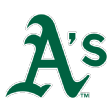
97-65 | AL wild card | 3% World Series odds
Odds by round
Wild-card round: 54% vs. Rays
ALDS: 28% vs. Astros
ALCS: 41% vs. Yankees. 47% vs. Twins
World Series: 29% vs. Dodgers, 41% vs. Braves, 51% vs. Cardinals, 57% vs. Brewers, 41% vs. Nationals
What they do better than everyone else: Oakland’s pitching staff as a whole really pounds the strike zone with fastballs. No team threw a higher rate of pitches in the zone this season, and no AL team threw a higher rate of fastballs. Their collective contact rate is also high, so that allows Oakland to put its third-ranked defensive efficiency to work. However, the Athletics’ pitchers are one of the more fly ball-prone staffs, a design that works great at home, where the A’s went 52-29. Alas, the Athletics are a wild-card team, so their home mastery can only go so far in the postseason. — Doolittle
One flaw that could doom them: Oakland is susceptible to swing-and-miss pitchers, which is to say just about every hurler who sees action in October. The Athletics are baseball’s most-disciplined team in terms of chase rate, so opposing pitchers generally stayed in the zone against them. Only three teams swung and missed more often than launch-angle-obsessed Oakland, and we’ll have to see how this take-and-rake strategy plays out against superior staffs. During the season, Oakland’s .714 OPS this season against power pitchers ranks behind every other postseason team except for wild-card opponent Tampa Bay. — Doolittle
Their Mr. Excitement: Marcus Semien should finish in the top-five of the MVP voting after a superb two-way season that saw him bash over 80 extra-base hits and potentially win his first Gold Glove. — Schoenfield
Their best player you’ve never heard of: Outfielder Mark Canha entered his age-30 season this year as a career .239/.305/.424 hitter; he didn’t even start in last year’s wild-card game against the Yankees. But since he returned in mid-May from a stint on the injured list, he has been one of baseball’s dozen best hitters, moving from eighth in the A’s lineup to the cleanup spot. He’s a local product (high school in San Jose, college in Berkeley) who was acquired a few years ago when the Miami Marlins left him exposed in the Rule 5 draft, free to anybody who would merely promise to keep him on a big league roster for a year. — Miller
Their season in a game: The three AL teams who struck out fewer batters than Oakland this year averaged more than 100 losses, but the A’s have such a strong defense that their contact staff survived even this juiced-ball season. Oakland finished third in defensive efficiency — the measure of how many batted balls they turned into outs — and, despite a fly ball staff, kept the ball in the yard, especially at home. Consider Mike Fiers‘ no-hitter against the Reds on May 7th: He struck out only six batters, tied for the fewest in a no-hitter since 2013, and “should” have allowed about four hits, according to Statcast. He even allowed one batted ball over the center field wall. But defense is a collaborative effort, and the A’s defense is as significant as their pitching. — Miller
Passan’s Inside Intel: “They have a better chance to beat (the Astros) than New York,” said a scout who recently saw the A’s. “They have a better chance to beat them than anyone outside of the Dodgers.” … One scout sees benefits and detriments with the A’s reliance on dynamic left-handed rookies Jesus Luzardo and A.J. Puk out of the bullpen. “I’m high on Puk and Luzardo — and they’ve never pitched a game in October,” he said. “It’s tough to rely on young players. The moment is massive. There’s only one game on TV. And they’re in it. It’s something the A’s have consistently struggled with under Billy Beane — and it’s not his fault. The A’s are always youthful, which is great, because every year in August and September you see them thrive, and it’s due to them having a tremendous amount of youthful players. They’re not tired.”
“Count up their walk-off wins,” one scout said, so we did: 10, tied with Tampa Bay for the most in the AL. “They battle you for 27 outs. They’re deep through the lineup. That’s where they’re dangerous. And they’re not afraid of Houston because they beat ’em six of eight times. I think Oakland is the only team that can keep Houston from the World Series.” … Sean Manaea, who’s expected to play a pivotal role in the wild-card game, has blown away scouts as much as he has hitters in spite of a fastball with below-average velocity. “He’s deceptive. He can command it. And he can spin it,” said a scout who took in a recent start. “In today’s game, everyone throws 95. A guy like Manaea can beat you with 90. He’s an old-school pitcher. The guys you have to watch out for are the Manaeas.”

NLDS: St. Louis Cardinals vs. Atlanta Braves
The Braves won their most games since 2003, riding the big four of Freddie Freeman, Josh Donaldson, Ronald Acuna Jr. and Ozzie Albies on offense and a solid pitching staff led by rookie Mike Soroka and free agent Dallas Keuchel. The bullpen additions at the trade deadline strengthened what had been a weakness. Acuna missed the last few games of the regular season, nursing a sore groin, and Freeman missed a few games the final week with a bone spur in his right elbow that has bothered him for two months. The Cardinals had to use second-half stud Jack Flaherty (0.91 ERA) to clinch the division title, but all is not lost: Flaherty can start Game 2 and, thanks to the 2-2-1 schedule, be back for Game 5 on full rest. The Cardinals’ best chance of beating the Braves probably goes through two gems from Flaherty.
St. Louis Cardinals

91-71 | NL Central champs | 5% World Series odds
Odds by round
NLDS: 43% vs. Braves
NLCS: 32% vs. Dodgers, 58% vs. Brewers, 39% vs. Nationals
World Series: 41% vs. Yankees, 26% vs. Astros. 47% vs. Twins, 50% vs. A’s, 50% vs. Rays
What they do better than everyone else: The Cardinals combine a somewhat old-school pitching design with a team defense that has gone from shaky to shimmering under Mike Shildt. The results have been hard to argue with and the keep-the-ball-in-play approach will be put to these test against the legion of long ball mashers in the postseason. St. Louis has been more solid than spectacular with its run prevention, with an error total that is one of the lowest team totals ever recorded. It’s the type of thing that plays out over a long stretch of games, but how will that no-mistakes thing play in a short series? — Doolittle
One flaw that could doom them: The St. Louis batsmen have been consistently befuddled by off-speed and breaking pitches, leading to an offense that has underachieved at the top line and been maddeningly inconsistent to boot. Part of this is by design — the Cardinals have selected more for run prevention than run creation as they’ve doled out playing time. But none of this explains the sub-forecast numbers from Paul Goldschmidt and Matt Carpenter, the latter of whom lost his everyday spot. If Kolten Wong‘s sore hammy lingers, Carpenter may be back in the harness. So next week would be a good time for St. Louis’ preordained sluggers to regress. Otherwise, it will be incumbent on the Redbirds’ run-prevention units to keep scores low. — Doolittle
Their Mr. Excitement: I have to break my rule here and pick a pitcher, because Jack Flaherty is pitching right now like Bob Gibson in 1968 or Pedro Martinez in 1999 or — OK, maybe I’m getting carried away with those comparisons, but that’s how dominant Flaherty has been in the second half. Here’s another one: Orel Hershiser in 1988. Like Hershiser, Flaherty could carry the Cardinals on his back all the way to a title. — Schoenfield
Their best player you’ve never heard of: It’s the Cardinals’ annual Mid-Round Draft Pick Who Becomes Incomprehensibly Valuable! Tommy Edman was ranked just 12th among Cardinals prospects before the season began but ended up taking playing time from Matt Carpenter at third base and finishing with 3.9 WAR — more than Kris Bryant, Manny Machado, Josh Bell, Jose Altuve — in just 92 games. He’s fast, plays great defense at third or second and hit more homers in a half-season in the majors than he had hit at any minor league level. — Miller
Their season in a game: The Cardinals’ infield defense, especially since Edman took the bulk of playing time from Carpenter, has been extraordinary: They have the best defensive efficiency on ground balls this year, and all four everyday infielders — Kolten Wong, Paul DeJong, Edman and Goldschmidt — rate among the league’s best at their positions by defensive runs saved. That has helped the Cardinals’ ground ball-heavy staff outperform its FIP, especially Dakota Hudson, who leads all qualifying starters in ground ball rate. When the Cardinals beat the Giants 10-0 on Sept. 5, Hudson struck out only two batters. He got 11 ground balls (against six flies and three line drives), and those 11 ground balls produced 10 groundouts. — Miller
Passan’s Inside Intel: No team comes into the NL playoffs with a hotter rotation than the Cardinals — and that goes beyond Flaherty, who, one scout said, “is the fourth-best pitcher in the playoffs behind [Justin] Verlander, [Gerrit] Cole and [Max] Scherzer.” Hudson, who could get the Game 1 nod, “throws a really heavy ball and isn’t afraid to work inside.” He has thrown the fourth-most inside pitches in the NL this season, according to Tru Media. … “Their offense is a lot like the Rays’,” said one scout who saw them recently. “No one’s a real threat, like [Mike] Trout or [Christian] Yelich, but no one is a zero.”
There are quite a few skeptics of the Cardinals despite the recent success of their starters. While they had the best rotation ERA in the big leagues in September, their 4.54 bullpen ERA this month was 19th in baseball. Among playoff teams, only Washington was worse. “They won a weak division,” said another scout who advanced them recently. “Cincinnati wasn’t good. Pittsburgh wasn’t good. The last six weeks the Cubs weren’t very good. [The Cardinals] got away with mistakes that good teams won’t make.” … “What’s going to help them,” the scout advancing St. Louis said, “is they don’t kick the ball around.” The Cardinals’ 66 errors were the fewest in baseball — less than half of the major league-worst 133 they committed a year ago.
Atlanta Braves
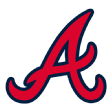
97-65 | NL East champs | 3% World Series odds
Odds by round
NLDS: 58% vs. Cardinals
NLCS: 36% vs. Dodgers, 49% vs. Nationals, 65% vs. Brewers
World Series: 48% vs. Yankees, 32% vs. Astros. 54% vs. Twins, 59% vs. A’s, 59% vs. Rays
What they do better than everyone else: The Braves won 28 one-run games this season and went 13 games over .500 in such contests, easily the highest marks among all postseason clubs. Of course, this is a good news/bad news trait. Winning close games is certainly important during the playoffs, but the fact that the Braves were good at it during the regular season tells us little about whether they can keep excelling at this most volatile of categories. However, at least some of there good one-run record traces back to performing in the clutch: Atlanta led the NL in run differential in high-leverage situations. — Doolittle
One flaw that could doom them: The bullpen has been a roller coaster for the Braves for much of the season, even after they picked up Chris Martin, Shane Greene and Mark Melancon during the season. Things have looked better during September, when Atlanta has posted a 3.60 bullpen ERA with Melancon locking down the ninth-inning role. Greene has pitched well of late, and lefty Sean Newcomb seems to be an emerging weapon after being demoted from the rotation early in the season. However promising the trends are, there are still fewer swing-and-miss dominators relative to MLB’s other playoff teams. It remains a concern. — Doolittle
Their Mr. Excitement: Ronald Acuña Jr. hit 41 home runs and stole 37 bases. He plays with the flair and the enthusiasm you would expect from a 21-year-old. Really, call him exciting doesn’t do Acuna justice. We need to invent a more descriptive adjective for him. — Schoenfield
Their best player you’ve never heard of: Only one left-handed batter has a bigger platoon split in his career than Matt Joyce — it’s Joc Pederson, if you’re curious — but he’s always ready to mash a righty, even off the bench. This year, the Braves got Joyce the platoon advantage in 89% of his plate appearances and he rewarded them with the majors’ seventh-best OBP, minimum 200 plate appearances. He started only eight games in the first half, but since mid-August he has been starting most days, giving the Braves a fifth good hitter. — Miller
Their season in a game: The Braves’ lineup is impressively top-heavy: They have four of the top 35 hitters in baseball, by Baseball-Reference’s WAR, while their fifth-best hitter ranks just 228th. The clustering of Acuña, Albies, Freeman and Donaldson is offensive Gummiberry juice at the top of the order, with those four averaging more than 110 runs and 100 RBIs apiece. When the Braves beat the Twins, 12-7, on Aug. 6, those four had 11 hits, scored 10 runs, drove in eight, collectively hit for the cycle and even stole two bases. Their slash line for the day: .579/.636/1.053. The rest of the lineup, even with a DH instead of the pitcher hitting, batted .208/.240/.208, but the Braves’ top four were still enough to batter a playoff team. — Miller
Passan’s Inside Intel: Scouts who have seen third baseman Josh Donaldson recently rave about his focus. “Never takes a pitch off,” one said. His fielding, the scout said, is elite, and his bat this season has been awfully good, too: .259/.379/.521 with 37 home runs, 94 RBIs and 100 walks. He figures to cash in big on a three-year deal this winter. … What makes the Braves capable of beating anyone? “A healthy [Ronald] Acuna, [Ozzie] Albies, [Freddie] Freeman and Donaldson,” one scout said. A groin injury sidelined Acuna for the final half-week of the season, and Freeman has fought painful bone spurs in his elbow. Both are expected to be ready for Game 1 on Thursday against the Cardinals.
After months of mediocrity, Mike Foltynewicz‘s results in September started to resemble the All-Star version of himself from 2018. The stuff, however, is not the same. “He’s still a power guy,” said a scout who saw his most recent start Saturday, “but he’s not going to blow you away like he did last year.” He is lined up to start Game 2, with rookie Mike Soroka slated for Game 3, due to his road ERA coming in at less than half of his ERA at SunTrust Park (1.55 vs. 4.16). … Blunt assessment on the Braves’ arms from a scout: “I don’t think their pitching is enough. I definitely think their bats are. If Folty deals, they might have a shot. But I don’t love the back end of the bullpen.” The combined September numbers for their three deadline bullpen acquisitions, closer Melancon and setup men Greene and Martin: 25 innings, 15 hits, three walks, 22 strikeouts and a 1.80 ERA.

NLDS: Los Angeles Dodgers vs. wild-card winner
The Dodgers won a franchise-record 106 games, but perhaps no team faces more pressure after two straight World Series defeats. The lefty power-hitting trio of Cody Bellinger, Joc Pederson and Max Muncy combined for 118 home runs, but two rookies, catcher Will Smith and second baseman Gavin Lux, could play a huge part in their October success. Of course, it might ultimately come down to the two longtime Dodgers finally putting it all together in the postseason: Clayton Kershaw and Kenley Jansen.
Los Angeles Dodgers

106-56 | NL West champs | 26% World Series odds
Odds by round
NLDS: 73% vs. Brewers, 60% vs. Nats
NLCS: 70% vs. Cardinals. 64% vs. Braves
World Series: 63% vs. Yankees, 44% vs. Astros. 69% vs. Twins, 71% vs. A’s, 71% vs. Rays
What they do better than everyone else: The Dodgers own the NL’s best fielding-independent ERA because they are good at all three components of that metric. L.A. ranks second among senior circuit teams in strikeouts, and allowed both the fewest walks and fewest home runs. It’s a pretty good combination. Add to this the fact that the Dodgers also led the NL in defensive efficiency, and you have a complete run-prevention formula. Indeed, no team gave up fewer runs this season, and L.A. led the NL in both home and road ERA. The Dodgers can hit, too, but their run prevention is what marks them as NL favorites. — Doolittle
One flaw that could doom them: The default answer here all season has been closer Kenley Jansen, but that’s kind of obvious and he’s been throwing well lately, so let’s pick on the starting pitchers. The Dodgers own — by far — baseball’s best rotation ERA, but the numbers in September haven’t been as sparkling. More important is who has been experiencing the down-ticks. Walker Buehler and Clayton Kershaw have not exactly been ace-like down the stretch, and Hyun-Jin Ryu has picked it up but is still not completely back to his first-half form. This is all probably nothing, but we’ve got to give Dodgers fans something to worry about. — Doolittle
Their Mr. Excitement: Cody Bellinger is the favorite for MVP honors after one of the best seasons in Dodgers history. He not only bashes home runs, is a plus runner and plays a marvelous right field (while also filling in at first base and center field), but he looks ultra-cool doing it, with that upright stance as he crowds the plate and then unleashes one of the most unique swings in the game. — Schoenfield
Their best player you’ve never heard of: The other other Will Smith is all but nonexistent on Google searches, but he was a hyped prospect entering the season, and after getting called up for good in early July he took over as the Dodgers’ primary catcher. He has the second-highest launch angle in baseball this year, and, consequently, the 10th-highest HR/AB rate in the majors. — Miller
Their season in a game: I’m not sure how many players you could randomly remove from the Dodgers’ 40-man roster and still have a playoff team, but I wouldn’t be surprised if it was more than a dozen. The Dodgers had 13 pitchers throw at least 25 innings with a better-than-average ERA, and 11 hitters bat at least 150 times with an above-average OPS. That extraordinary depth was probably most evident in a three-game series against the Rockies, capped off by a 6-3 victory over Colorado on June 23. Smith won it with a walk-off home run, the third game in a row in which a different rookie had a walk-off homer. Kenta Maeda started the game and went seven strong innings; the Dodgers are so deep he won’t even make a postseason start. — Miller
Passan’s Inside Intel: After sitting Max Muncy against left-handed pitchers to start Games 1 and 2 of last year’s World Series and Bellinger in Games 1, 2 and 5, the Dodgers are almost certain not to rely on platoons with their two best hitters this season. “They are clearly better against righties,” one scout said. “But this idea that they can’t hit lefties is bulls—. They can do damage against anyone. Bellinger and Muncy have killed lefties this year.”
One scout believes the key not just to the Dodgers’ postseason but the entire playoffs is Buehler. “He wants to be the guy,” the scout said. “And he loves big games.” Buehler, who had the worst ERA among Dodgers starters in September, spent his last start tinkering with mechanics. … “I’m not sure any team is more effective at working in the upper part of the zone,” another scout said. “It’s hard because you want to lay off those pitches, but they do a great job of moving hitters’ eye levels and sequencing.”
The construction of the Dodgers’ bullpen could vary from round to round, depending on the matchups they face. The certainties: closer Jansen, Maeda, Julio Urias and Pedro Baez. While Joe Kelly‘s undisclosed ailment that has kept him out since Sept. 18 (though he faced two batters and threw six pitches against the Giants on Sunday) is of concern, there are plenty of arms to choose from otherwise, chief among them rookies Dustin May and Tony Gonsolin. Other options include Casey Sadler, Adam Kolarek, Ross Stripling, Caleb Ferguson, Yimi Garcia and Josh Sborz.

ALDS: Minnesota Twins vs. New York Yankees
In the year of the home run, it’s fitting that the two teams that cracked the 300 barrier will face each other in the ultimate Home Run Derby. The Twins had a record five players top 30 home runs, led by Nelson Cruz‘s 41. The Yankees have power up and down the lineup, with Gleyber Torres leading the team with 38. They also have Giancarlo Stanton back after he missed most of the season. Everyone will point to the Yankees’ edge in the bullpen, but Minnesota’s top three of Taylor Rogers, Trevor May and Tyler Duffey all had ERAs under 3.00, and veteran Sergio Romo has three World Series rings.
The cloud hanging over the Twins’ franchise: They lost ALDS to the Yankees in 2003, 2004, 2009 and 2010, and the Twins have lost 13 straight playoffs games since the first game of the 2004 ALDS.
Minnesota Twins

101-61 | AL Central champs | 7% World Series odds
Odds by round
ALDS: 43% vs. Yankees
ALCS: 27% vs. Astros, 54% vs. A’s, 54% vs. Rays
World Series: 31% vs. Dodgers, 46% vs. Braves, 53% vs. Cardinals, 60% vs. Brewers, 43% vs. Nationals
What they do better than everyone else: Since we’re awarding the crown of best homer-hitting team to the Yankees, that makes it more difficult to nail down the Twins’ standout trait. Across the board, everything the Twins do, the Yankees do a little better — and the Astros’ offense is better than both of them. But here’s one for Minnesota: No team has played better away from home. The Twins have flown past the 50-win mark away from Target Field. Minnesota has dropped two out of three at both Houston and New York this season, but at least we know they will be comfortable playing in hostile territories. — Doolittle
One flaw that could doom them: Because of injuries and performance dips, the Twins are really struggling to find functional starting pitching as the postseason dawns. Michael Pineda was rolling but was suspended by MLB. Jose Berrios has been solid down the stretch but not dominant. Jake Odorizzi has been pretty dominant but tweaked his hamstring recently. Kyle Gibson and Martin Perez have been getting bombed. Piecing all of this together, perhaps with bullpenning and/or use of an opener is going to be an enormous challenge for first-year manager Rocco Baldelli. Rookie surprise Randy Dobnak has thrown well and figures to be part of the solution in some capacity. — Doolittle
Their Mr. Excitement: You could pick any of their record-setting five players who hit 30-plus home runs, especially with defensive whiz Byron Buxton out for the season. It seems weird to pick a 39-year-old designated hitter here, but Nelson Cruz feels like the focal point of this offense, a slugger who might have hit 50 if he hadn’t missed 40 games. Don’t forget: Cruz has a storied postseason history with 16 home runs in 41 games. — Schoenfield
Their best player you’ve never heard of: A few things about Mitch Garver: His slugging percentage is the seventh-highest ever for a catcher, minimum 300 plate appearances; with 31 home runs in 311 at-bats, he had a HR/AB rate that only 11 big leaguers in history have ever surpassed in a season; he has the sixth-highest slugging percentage ever for a leadoff hitter (min. 100 PA in that spot); and he started the year as a 28-year-old backup catcher with seven career home runs. — Miller
Their season in a game: The Twins have the highest fly ball rate in baseball and became the first team ever to hit 300 homers in a season. They are especially aggressive early in the count, have the lowest pitches/plate appearance among playoff teams, and often use a catcher with an extraordinary home run rate and zero career steals to lead off. And so, the game: a 16-7 win over the Orioles, April 20. The Twins hit 28 fly balls and only 13 grounders, and jumped on nine first pitches for two homers and two singles. Of course, they homered eight times. — Miller
Passan’s Inside Intel: “I think you’re going to see this with a lot of teams,” a scout said, “but it really goes for Minnesota: You can’t give them fastballs. There’s going to be so much spin and junk. They can hit it, but they just are so good at destroying fastballs, you can’t give it to them.” … The key for the Twins, according to another scout: right-handed reliever Tyler Duffey. “He’s turned into a real dude,” the scout said. “They were kicking themselves after the [Ryan] Pressly deal (in which they traded him to Houston), but they might have a guy that’s better.” To wit: Until Saturday, Duffey hadn’t allowed a run since July 23, spanning 26 outings. … “I trust their [starting pitchers] to work into the fifth,” the first scout said. “If the Yankees get a third time through the lineup, it’s gonna be trouble.” … “You can’t rely on working up in the zone against them,” said a scout who recently advanced the Twins. “They will punish high pitches.”
New York Yankees

103-59 | AL East champs | 11% World Series odds
Odds by round
ALDS: 57% vs. Twins
ALCS: 32% vs. Astros. 59% vs. A’s, 59% vs. Rays
World Series: 37% vs. Dodgers, 52% vs. Braves, 59% vs. Cardinals, 65% vs. Brewers, 49% vs. Nationals
What they do better than everyone else: Despite their second-half battle with Minnesota for all-time supremacy in the single-season home runs category, no team mashes like the Bombers, especially a quasi-healthy version of this club. Even if Edwin Encarnacion can’t go, the Yankees still would have at least a dozen healthy double-digit home run hitters to pick from in their playoff lineups. Giancarlo Stanton’s season was wrecked by injury but, then again, he’s probably looking to make something out his 2019 experience. Expect New York to live and die with the long ball as they’ve done all season during the year of the home run. — Doolittle
One flaw that could doom them: The troubles of the Yankees’ starting rotation this season have been puzzled over to a level that rates somewhere between overblown and hysterical. In a postseason context, the Yankees are set up to navigate around their rotation by letting them throw all-out for a couple of trips through opposing batting orders before Aaron Boone turns it over to his deep and intimidating bullpen. James Paxton is the only rotation member likely to be used as a traditional starter. Nevertheless, getting to the Yankees early and undermining the leveraged opportunities for Boone’s bullpen is the best path to beating New York. — Doolittle
Their Mr. Excitement: He’s not the team MVP in 2019, but this has to be Aaron Judge. After missing most of May and June, he’s finished strong with 15 home runs the final two months, so he can crush any mistake. Then there’s the underrated aspect of his game: Judge is a terrific right fielder with range and a strong arm, a Gold Glover in the league if it didn’t have Mookie Betts. Judge’s first playoff series in 2017 was a rough one when he struck out 16 times in 20 at-bats against Cleveland, but he has seven home runs and a .627 slugging percentage in 18 career playoff games. — Schoenfield
Their best player you’ve never heard of: In 2018, Gio Urshela hit .286/.326/.393-in Triple-A, for three different organizations. It’s not clear he’d have appeared in a single game for the Yankees this year if not for a fluke diving injury to starting third baseman Miguel Andujar in the third game of the season. Urshela had one of the league’s best line drive rates and the 17th best expected batting average (according to Statcast measures). If he had the 26 extra plate appearances needed to qualify, he would have finished fourth in the AL in batting average, batting .314/.355/.534 overall. Plays a solid third base, too, unlike the player whose unfortunate injury gave him his opportunity. — Miller
Their season in a game: The three storylines about the Yankees this year: extraordinary depth; wildly outperforming any expectations from what has been, essentially, their second-string lineup for much of the year; extraordinary bullpen dominance, with four relievers averaging at least 12 Ks per nine innings (unprecedented) and a fifth, Zack Britton, whose ERA is under 2.00; and extraordinary power, with nearly two homers per game. Their game: a 5-2 win over San Diego on May 27. Both runs were allowed by their “bulk” reliever, David Hale; before and after him, Chad Green, Adam Ottavino, Tommy Kahnle, Britton and Aroldis Chapman threw five shutout innings, striking out nine and allowing three baserunners. Three Yankees homered, including Clint Frazier (starting in right field for the injured Aaron Judge), who drove in the Yankees’ first run. Frazier was later replaced by Cameron Maybin, who drove in the final run. Their No. 9 hitter, Brett Gardner, homered too; he would hit 27 on the year. So much power, on the mound and at the plate. — Miller
Passan’s Inside Intel: For all of the Yankees’ regular-season excellence and perseverance, scouts who have seen them recently believe they’re vulnerable. “They are very beatable,” one scout said. “I say that with all due respect to the guys they have injured. You can pitch to a lot of their guys. I was shocked at how much you can pitch to DJ LeMahieu. [Aaron] Judge and Gleyber [Torres], you can get both those guys out. [Edwin] Encarnacion is more of a mistake guy.” … Hold on. Pitch to LeMahieu, who is batting .331 and should get down-ballot MVP votes this season? “If you jam him inside and play him to pull,” another scout concurred, “he’ll get himself out.” … Another scout’s slightly more sanguine take: “They have a great bullpen … ” Then he followed “… and they’re going to get to it early. I think that could be a problem.
Losing [Domingo] German (to a domestic violence-related incident) is a huge factor for them. He was either a swingman to get them through 4-5-6 or he was going to start. They just don’t have the depth in that rotation.” … There remain believers, including one front-office executive: “They won almost 105 games with the most players ever on the injured list. I don’t bet against that.”
ALDS: Houston Astros vs. wild-card winner
The Astros enter the postseason as the World Series favorite for obvious reasons and figure to have a big edge over either the Rays or A’s here. Justin Verlander, Gerrit Cole and Zack Greinke form an imposing rotation trio. The powerful offense ranked third in the majors in home runs, first in batting average and first in lowest strikeout rate. The bullpen had the third-best ERA in the majors. They ranked fourth in defensive runs saved. Alex Bregman is an MVP candidate and Michael Brantley and rookie slugger Yordan Alvarez provide help from the left side that the team lacked a year ago. It’s a team without a weakness and it begins the postseason in better health than last season (although Carlos Correa‘s back is a concern).
Houston Astros
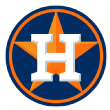
107-55 | AL West champs | 33% World Series odds
Odds by round
ALDS: 72% vs. A’s, 72% vs. Rays
ALCS: 68% vs. Yankees, 73% vs. Twins
World Series: 56% vs. Dodgers, 68% vs. Braves, 74% vs. Cardinals, 79% vs. Brewers, 66% vs. Nationals
What they do better than everyone else: There are a lot of things the Astros do better than everybody else, but their rotation is the most fearsome part of the Houston dossier at the moment. Nationals fans might dispute whether Houston has the better playoff rotation, but no one can combine the track records of Justin Verlander, Gerrit Cole and Zack Greinke with the kind of recent dominance that trio has shown. Sure, there could be a step down when Houston gets to its No. 4 but, then again, given the way rookie Jose Urquidy has thrown lately, concerns about Wade Miley might be irrelevant. — Doolittle
One flaw that could doom them: The Astros are a very complete team. If anything, you look at the bullpen as a possible weakness, if only in relation to the rest of the roster. Houston’s save percentage is better than average and their rate of stranding inherited runners ranks fifth. So we’re not talking glaring weaknesses here. There’s no lefty in the bullpen, unless Miley is moved there, but that hasn’t been a problem for the Astros all season. Closer Roberto Osuna has been excellent and has a lot of postseason experience. If he slumps, chaos ensues. There’s just no reason to think he’ll slump. — Doolittle
Their Mr. Excitement: Just one? That’s like choosing your favorite Beatle or your favorite “Seinfeld” episode or your favorite variation of Diamondbacks uniform. Look, Verlander and Cole are going to finish 1-2 in the Cy Young voting and are capable of a dozen strikeouts every time out, but they don’t play every day. Yordan Alvarez is a rookie slugger of prodigious ability, but he doesn’t play in the field. George Springer had his best season and has been a World Series MVP. Jose Altuve is still a marvel. But for 2019, I have to go with Alex Bregman, who may be the AL MVP, plays all over the infield (whether at shortstop or in a shift), loves the spotlight and has the energy to earn the title Mr. Excitement. — Schoenfield
Their best player you’ve never heard of: Maybe the league’s most overlooked reliever over the past five years, Will Harris has the fifth-best ERA+ of any pitcher in that stretch — better than Craig Kimbrel, better than Kenley Jansen — while bouncing between roles in the Houston bullpen. On 20 other teams, he’d be the established closer with 175 career saves. But with Houston he settles for just his few saves a year — when the regular closer is struggling or unavailable — as well as his annual postseason bonus check. — Miller
Their season in a game: The Astros’ pitching was extraordinary this year, led by Cole and Verlander. But in the year of the juiced ball, even the two Cy Young co-favorites were vulnerable to home runs. The offense, meanwhile, led the majors in walks drawn and had the fewest strikeouts, as Houston set a franchise record for wins. The game, then: a 14-3 win over Colorado, Aug. 7. Cole struck out 10 and walked nobody in six innings, allowing only two runs on two solo homers. The Astros walked nine times, struck out only nine times, and, fittingly for a team that began the season with 96% playoff odds, had a big lead after the first inning. It was all cruising after that. — Miller
Passan’s Inside Intel: The questionable status of shortstop Carlos Correa could alter the makeup of the Astros’ lineup — but not irreparably. Alex Bregman has played admirably at shortstop all season. And considering how Correa’s balky back has hampered him, he is at best a question mark. … The construction of the Astros’ roster is of great interest. Even without Correa, their depth is evident. Guarantees to make the roster: Bregman, Yordan Alvarez, Jose Altuve, George Springer, Michael Brantley, Yuli Gurriel, Martin Maldonado and Robinson Chirinos. Depending on how many pitchers the Astros carry, there could be an odd man out among the remaining players: Josh Reddick, Kyle Tucker, Jake Marisnick, Abraham Toro, Myles Straw and Aledmys Diaz.
If you’re going to beat the Astros, the clearest path may be by dialing down the radar-gun numbers. “They murder fastballs,” said one scout who has advanced them most of September. “They’re the best breaking-ball-hitting team in the big leagues. But they struggle with changeups and splitters and soft stuff.”
“You have to jump on Cole and Miley early,” another scout said. “Because if you do, they don’t have that two- or three-inning, young power guy to bridge the gap to the late innings. You can take advantage of that.” … “They just take such good at-bats,” a third scout said. “Even when they’re behind.” He’s right: Astros hitters have the best OPS in baseball of players down in the count. … Nearly every evaluator believes the Astros are going to win the World Series. Said one: “Best team on paper. They’re deep in the rotation. They’re built for a five- and seven-game series. The first three starters for the Astros might be the three best starters in the postseason. You’re not gonna score a lot.”
